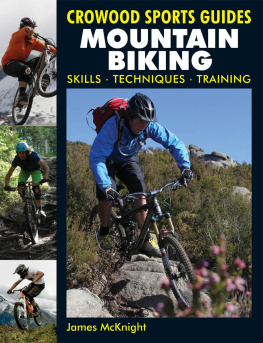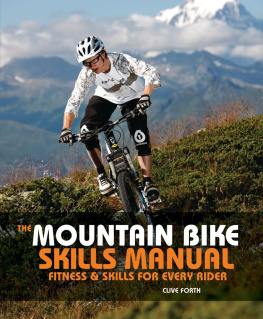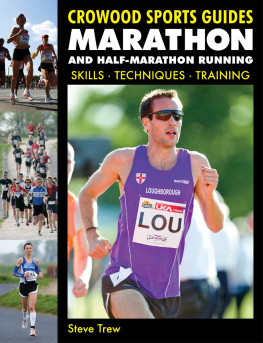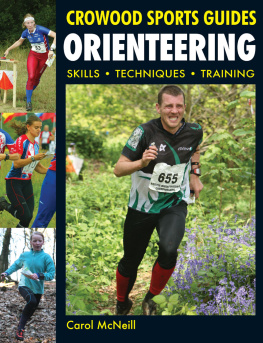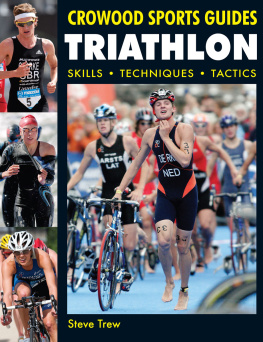CROWOOD SPORTS GUIDES
MOUNTAIN
BIKING
SKILLS TECHNIQUES TRAINING
James McKnight

THE CROWOOD PRESS
First published in 2012 by
The Crowood Press Ltd
Ramsbury, Marlborough
Wiltshire SN8 2HR
www.crowood.com
This e-book first published in 2014
The Crowood Press Ltd 2012
All rights reserved. No part of this publication may be reproduced or transmitted in any form or by any means, electronic or mechanical, including photocopy, recording, or any information storage and retrieval system, without permission in writing from the publishers.
British Library Cataloguing-in-Publication Data
A catalogue record for this book is available from the British Library.
ISBN 978 1 84797 857 8
Acknowledgements
A special thanks to photographer Chris Jackson of Kingdom Bikes for his great photography.
Also thanks to Bertie Maffoons bike shop in Marlborough, Wiltshire for help with the maintenance sections.
Thank you to my family, friends and to Isobel for helping me with my efforts.
And for their help, thank you to Trek, Osprey, Teva, Royal and The North Face.
Photography by Chris Jackson/kingdombike.

CONTENTS

CHAPTER 1
HISTORY OF THE SPORT
Introduction to Mountain Biking
Mountain biking is the off-road form of cycling that has become widespread over the last two decades and is fast becoming the most popular two-wheeled sport. Accessible to all ages, fitness and skill levels, a year-round sport and applicable to any location hillside or plateau mountain biking is perhaps the most versatile sport of the moment.
History
Bicycles have been ridden off-road ever since their invention; however, the first recordings of mountain biking are hazily recounted from somewhere in the late 1970s when a group of hippies in Marin County, USA, began to take their klunkerz (beach cruisers) to the hills and race down dirt tracks.
During the 1980s, the term mountain bike was coined and Gary Fisher started to produce geared off-road bicycles. From what started so humbly, the sport soon became a craze and by the early 1990s there were televised events, professional riders and a global race series.

Mountain biking is for everyone; its fun, healthy and environmentally friendly.

The sports founders pushed and carried their basic bikes up mountains in the USA.
That craze died off somewhat around the middle of the decade. However, the sport continued to thrive and progress, with new technologies constantly developing the sport and feeding a hungry consumer market. Currently the sport is having a rebirth as adventurers and families alike begin to realize the potential of the modern mountain bike, with an increasing number of trail centres and summer resorts creating an ever-growing abundance of biking terrain, and paving the way for future generations of mountain bikers.
Early Competitions
Mountain biking was born as a competition sport and yet only considered mildly competitively natured. The majority of riders were hippies and the race meeting was considered more important than the racing itself. However, with the increase in popularity and the invention of the saleable mountain bike, the sport sprouted many high-profile competitions, some of which continue to run to this day:
Fat Tyre Festivals were huge events that originated in the USA and that included all the fanfare of a music festival. The most famous event took place in Moab, Utah and paved the way for the place to become one of the most visited mountain bike destinations in the world. |
The UCI World Cup commenced in 1989 and has since included disciplines such as dual slalom, dual, four-cross, downhill, trials and cross-country; the latter three of which comprise the modern day series. |
The first World Championships took place in 1990 in Durango, Colorado with the winners taking home the now much-coveted rainbow striped jersey. The Worlds is the most important single event on the mountain bike calendar and some racers focus their entire season on the one event. |
The Kamikaze Downhill is a now legendary race that took place on Mammoth Mountain, USA. The event was a head-to-head eliminator race down the high-speed fire-roads on the mountainside and claimed many casualties, eventually leading to its retirement from the racing calendar. |
National Championships now take place the world over, mostly on the same date so as not to clash with international racing commitments the exception to this rule is for some southern-hemisphere countries who prefer to host their championships in the middle of their summers. |
The Malvern Classic was once the biggest event on the UK calendar and brought riders from all disciplines together at a site in the Malvern Hills. This event had a true festival atmosphere with various races taking place over the course of the event and on-site bars, live music and camping for all. |
The Olympics first accepted mountain biking to the roster in 1996 and the event has been a huge success. Only cross-country racing is included in the mountain bike Olympics but the majority of riders also hope to see downhill brought to the event. |

Mountain biking is a world-wide sport.
Names and Nations
Mountain biking was invented in the USA and the country has always had a strong presence on the mountain bike scene, but these days there are other nations who dominate the sport with higher participation figures and champions across the sports disciplines.
The UK has one of the highest participation rates in the world along with some of the best infrastructure, both of which create a huge amount of revenue from the sports tourism they create. There are dozens of trail-centres (dedicated bike destinations with all-weather, purpose built trails) in the UK, which generate millions of pounds for the economy. The sport is fronted by hugely successful riders, particularly in downhill the likes of which include Steve Peat, Gee Atherton and Danny Hart. |
New Zealand has the terrain and the attitude to sport that is needed for mountain biking and, unsurprisingly, is one of the strongest nations in terms of racing results: Justin Leov and Cameron Cole are two of the most successful riders of the moment. Although more sparse than in the UK, there are bike parks and trails appearing all over the country making it the top winter destination for all bike riders. |
Australia is a true sporting nation, which puts a lot of money into funding for its future sports stars. Mountain biking is no exception with many top athletes including Cadel Evans (who now races in road cycling), Sam Hill and Chris Kovarik. However, facilities are minimal in comparison to other leading countries and there is little in the way of prepared trails. |

